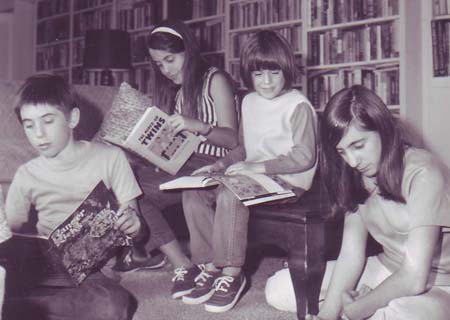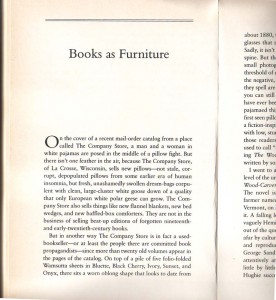How I Began Building With Books
I was raised with a near-religious relationship to books.
Never  write in a book. Don’t lose someone else’s place. How to protect its vitally-important spine. Rules pertaining to the avoidance of moisture. And, like all observant families, we were taken once a week to the library for worship.
write in a book. Don’t lose someone else’s place. How to protect its vitally-important spine. Rules pertaining to the avoidance of moisture. And, like all observant families, we were taken once a week to the library for worship.
Years ago, for all the right reasons, I decided to minimize the use of
new lumber in my woodworking. I found I could count on an inexhaustible supply of wood, mainly from discarded futon frames. These became everything from beds, and shelving to boxes and trophies.
Still, I envied rural craftspeople who could spend time in the woods, gathering elegant natural materials for their work. I was relegated to what I could find on the sidewalk and in Dumpsters, my head swiveling as I passed each pile of discards.
 Upon reading Nicholson Baker’s, “Books as Furniture,” in The New Yorker, I wondered if books could be lumber, what sort of furniture would I make? The bookshelf pun popped up and I drew a sketch. But it took me 7 years to get the guts to make the first one. (Note: In Baker’s essay, “Lumber”, I learned that the term once applied to more than just wood. It also meant the ideas stored in your head.)
Upon reading Nicholson Baker’s, “Books as Furniture,” in The New Yorker, I wondered if books could be lumber, what sort of furniture would I make? The bookshelf pun popped up and I drew a sketch. But it took me 7 years to get the guts to make the first one. (Note: In Baker’s essay, “Lumber”, I learned that the term once applied to more than just wood. It also meant the ideas stored in your head.)
![]() I began to collect discarded hardbacks that caught my eye. I haunted recycling centers and pawed through library discards. There, flocks of dealers hover in wait, but leave behind outdated references and novels no one will read or collect. At first I was drawn to the subjects and titles, then to the color and texture of the covers.
I began to collect discarded hardbacks that caught my eye. I haunted recycling centers and pawed through library discards. There, flocks of dealers hover in wait, but leave behind outdated references and novels no one will read or collect. At first I was drawn to the subjects and titles, then to the color and texture of the covers.
I brought these to my workshop and began to experiment, trying to link up their sizes, colors, textures, and wherever possible, their meanings. Next, I carefully remove and recycle the pages, retaining the jackets for use as an exotic, but demanding veneer.
This lumber carries its own rules, far stricter than any wood I’ve previously cut or planed. Traditionally, a woodworker must work around the imperfections in each piece of wood, trying to find the optimum use and orientation for each in a given project. Which is the good side? With books, the answers are culturally fixed; there is little choice. We read spine text in one direction. The cover is the cover. Nor do I significantly change the dimensions of a book.
Rigid limits like these appeal to my creative process. I do not respond well to open, fluid media where anything goes. I prefer to be put in a tight box from which I must struggle to escape.
